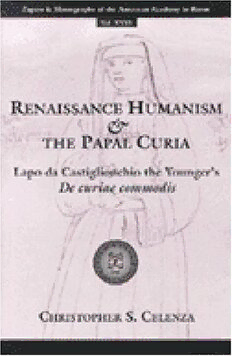
Renaissance Humanism and the Papal Curia: Lapo da Castiglionchio the Younger's De Curiae Commodis PDF
259 Pages·2000·1.009 MB·English
Most books are stored in the elastic cloud where traffic is expensive. For this reason, we have a limit on daily download.
Preview Renaissance Humanism and the Papal Curia: Lapo da Castiglionchio the Younger's De Curiae Commodis
Description:
Renaissance Humanism and the Papal Curia offers first a general introduction to the life and work of Lapo da Castiglionchio. Then a facing-page translation of and commentary on Lapo's complicated treatise, De Curiae Commodis , are offered. These illuminate both the text itself as well as Lapo's own situation and the humanistic era that De Curiae Commodis addresses. Born into a family of the feudal aristocracy in 1406, Lapo da Castiglionchio as an adult was a practitioner of the new art of humanism. A student and friend of noted humanist Francesco Filelfo, Lapo long sought admittance to the powerful circle at the Vatican's pinnacle. He failed in that goal but left us a document full of valuable details about the workings, goals, and interests of the papal curia. In the year he died, Lapo wrote the treatise De Curiae Commodis . This work is written elegantly, learnedly, and angrily. It is a human document alive with information for intellectual, social, and cultural historians. Christopher S. Celenza is Assistant Professor of History, Michigan State University, and has been elected a Fellow of Harvard University's Renaissance Study Center in Florence, the Villa I Tatti, for the next academic year (Sept. 1999-June 2000).
See more
The list of books you might like
Most books are stored in the elastic cloud where traffic is expensive. For this reason, we have a limit on daily download.
